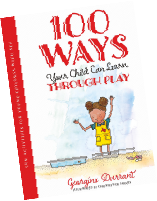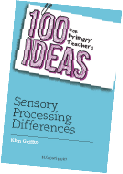Two new publications packed with ideas to support children and young people with play and with sensory processing. For a chance to win a copy for your school email: office2@speechlink.co.uk
Ways to Develop Speech, Language and Communication Skills Through Play

Play can help children to develop a whole range of skills from fine motor and gross motor skills to speech, language and communication skills.
In her new book 100 Ways your child can learn through play – Fun activities for young children with SEN, Georgina Durrant provides 100 creative and engaging ideas for children to learn while they play.
Nail Salon Activity
Description
Set up your very own nail salon, complete with cardboard nails to paint! Children will love asking their cardboard clients how they would like their nails painting today.
Equipment
Card, pencils, paints, brushes and sequins/glitter.
How to
- Help your child to draw around their hands onto the card.
- Support them to cut out the hands, then draw where the nails are.
- Encourage them to pretend they work in a nail salon, asking their ‘client’ how they would like their nails today, thinking about the colours, patterns and embellishments before painting the nails on the cardboard hands. Georgina Durrant is a former teacher/SENDCO.
Director of Cheshire SEN Tutor Ltd Founder of the award-winning website The SEN Resources Blog – www.senresourcesblog.com
Primary teachers – do you need some sensory inspiration?

Kim Griffin’s first book with Bloomsbury, 100 Ideas for Primary Teachers: Sensory Processing Differences, is a handbook of practical ideas and tips focussing on sensory processing.
Idea 77: Ear defenders
“We used the ear defenders during assembly and lunchtimes as they really helped Oscar to stay in the space and engage.”
Ear defenders, or noise-blocking headphones, are a common piece of sensory equipment. They can be helpful for pupils who are sensitive to sounds. Some pupils prefer ear plugs over ear defenders. Ear defenders won’t work for all pupils, as some pupils don’t like wearing them as they muffle sounds.
Typically, pupils will use the ear defenders during noisier periods.
This might be during music lessons, assembly or when in the lunch hall. Sometimes, pupils will wear them when they need to sit and focus on work. Other pupils will use them when their classmates start to become louder.
The pupil should be reasonably independent in putting these on and off. Some pupils might need a reminder to put them on. Other pupils will independently decide when they will use them.
More recently, noise-cancelling headphones are being used by some pupils. These can be expensive, and typically parents have purchased them. The noise-cancelling feature can be used with or without music playing.
Teaching tip
Teach the pupil to access the headphones when they need them. Have them freely available for the pupil to access and put on and off.
Bonus idea
For pupils with larger heads, sometimes gardening noise protection headphones are more comfortable as these come in adult sizes.
Kim Griffin is an occupational therapist with 20 years’ experience supporting children, their families and teachers. She currently provides online training, support, and online sensory assessments via her website GriffinOT.com
Please login to view this content
Login